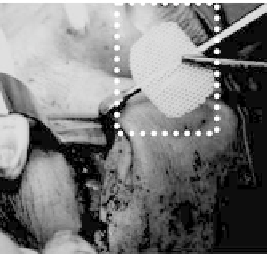Biomedical Engineering Reference
In-Depth Information
Biomolecules
Cells
Scaffolds
The construct
should support
cell attachment,
migration, growth,
and differentiation
in vitro.
The construct is
then implanted
in vivo
to repair a
defect and guide
tissue
development and
organization into a
mature and
healthy state.
FIGURE 2.1
Scaffold-based tissue engineering aims to promote the repair and regeneration of tissues
through the incorporation of cells and biomolecules within a 3-D scaffold system, which can be maintained
in vitro
culture conditions until implantation.
strategies are currently under experimental investigation. It is by no means clear what defi nes an
ideal scaffold/cell or scaffold/neotissue construct, even for a specifi c tissue type. The considerations
are complex and include architecture, structural mechanics, surface properties, degradation prod-
ucts, and composition of biological components. Furthermore one must consider the temporal and
spatial variations in each of these factors both
in vitro
and
in vivo.
10
Scaffolds in TEC have certain minimum requirements for their biochemical, chemical, and
physical properties. These properties include biocompatibility, angiogenesis, vascularization, and
chemotaxis issues; the scaffold must not be an agent for allergic reaction and disease transmis-
sion, and it must possess suitable gross architectural qualities, which are possible to produce via a
reproducible processing platform. There are also sterilization and administrative issues to contend
with. Scaffolds must provide suffi cient initial mechanical strength and stiffness to substitute for the
mechanical function of the diseased or damaged tissue, which is aimed at repairing or regenerating.
Scaffolds may not necessarily be required to provide complete mechanical equivalence to a healthy
tissue, but stiffness and strength should be suffi cient to at least support and transmit forces to the
host tissue site in the context. For example, in skin tissue engineering, the construct should be able
to withstand the wound contraction forces. In the case of bone engineering, external and internal
fi xation systems might be applied to take support and maintain the majority of load-bearing forces
until the bone has matured.
11































































































































































